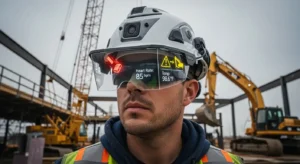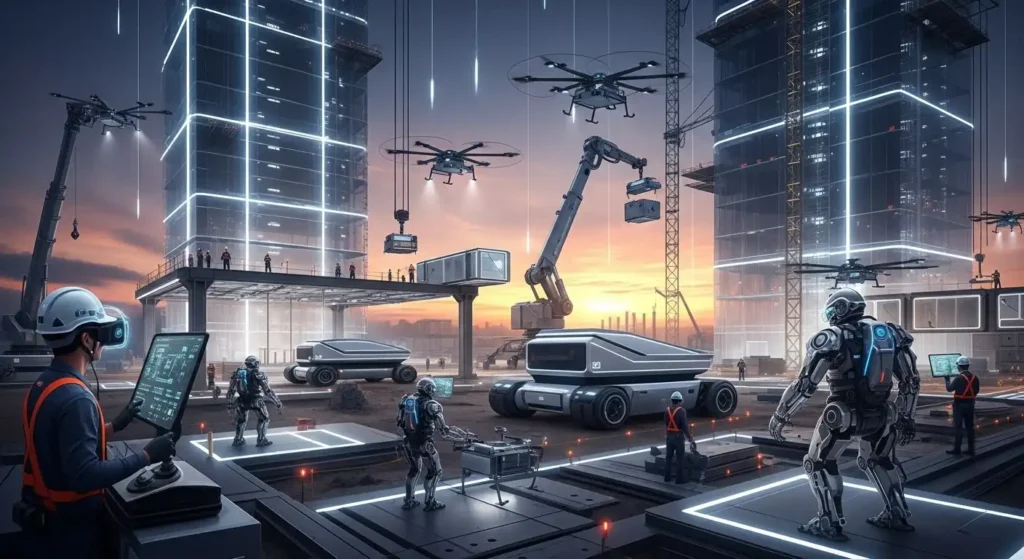Introduction:
Smart Helmets: The Future of Personal Safety on Construction Sites
 One of the most innovative AI-powered devices making waves in the construction industry is the smart helmet. These helmets are equipped with sensors, cameras, and communication tools that monitor a worker’s environment in real time. For example, smart helmets can detect hazardous conditions such as falling objects, proximity to dangerous equipment, or unsafe behaviors, alerting workers before accidents happen.
One of the most innovative AI-powered devices making waves in the construction industry is the smart helmet. These helmets are equipped with sensors, cameras, and communication tools that monitor a worker’s environment in real time. For example, smart helmets can detect hazardous conditions such as falling objects, proximity to dangerous equipment, or unsafe behaviors, alerting workers before accidents happen.
Smart helmets also offer the ability to track vital signs like heart rate and body temperature, providing health monitoring for construction workers working in extreme conditions. With AI-driven algorithms, these helmets can predict potential fatigue or health risks, helping prevent accidents caused by worker exhaustion or heat stress.
AI-Powered Drones for Site Inspections
Another cutting-edge technology making its way into construction safety is the use of drones. Drones equipped with AI can survey construction sites from above, providing detailed aerial footage and real-time data that can be analyzed for potential hazards. AI algorithms process this data to identify risks such as structural weaknesses, unsafe scaffolding, or improperly stored materials.
In addition to hazard detection, drones can be used to monitor worker activity and ensure compliance with safety regulations. AI-powered drones can even be programmed to deliver reports directly to site managers, allowing them to take quick action to address any safety issues. This technology not only helps reduce risks but also makes site inspections faster and more efficient.
Robotic Equipment: Minimizing Human Error and Injury
Robots are gradually replacing humans in some of the most dangerous and physically demanding tasks on construction sites. From bricklaying robots to robotic exoskeletons, these innovations are designed to minimize human error and reduce the risk of injury.
For example, robotic exoskeletons can be worn by construction workers to enhance strength and reduce strain on their muscles and joints. These wearable devices allow workers to lift heavier loads without the risk of injury, improving overall productivity while minimizing the potential for accidents caused by manual labor.
Additionally, robots are being used for tasks like welding, demolition, and even excavation, taking on high-risk jobs that would otherwise expose workers to harm. By utilizing robots in these areas, construction companies can drastically reduce the likelihood of serious injuries on-site.
The Role of AI in Safety Protocols and Training
 AI isn’t just about detecting hazards—it’s also being used to improve safety training. Traditional safety training methods can be slow, costly, and ineffective. With AI-powered simulations, workers can now practice emergency response scenarios in virtual environments, allowing them to prepare for various construction site emergencies without putting themselves in harm’s way.
AI isn’t just about detecting hazards—it’s also being used to improve safety training. Traditional safety training methods can be slow, costly, and ineffective. With AI-powered simulations, workers can now practice emergency response scenarios in virtual environments, allowing them to prepare for various construction site emergencies without putting themselves in harm’s way.
AI also plays a key role in identifying and analyzing workplace safety data. By analyzing patterns in past accidents and near-misses, AI can predict potential hazards and help site managers develop proactive safety strategies. This data-driven approach makes safety protocols more accurate and effective in preventing accidents.
The Future of Construction Site Safety: A Fully Automated Workforce?
The integration of AI and robotics into construction sites has already begun, but the future holds even greater possibilities. As AI technologies continue to evolve, we may soon see fully automated construction sites where robots perform almost every task, from building to inspecting and maintaining structures. While this vision may still be years away, the ongoing development of AI-powered technologies will continue to shape the future of construction safety.
For now, AI and robotics are playing a crucial role in transforming construction sites into safer, more efficient environments. By embracing these innovations, construction companies are not only improving safety but also maximizing productivity and reducing costs.
Conclusion:
The construction industry has long been associated with dangerous working conditions, but the rise of AI and robotics is changing that. As smart helmets, AI-powered drones, and robotic equipment continue to enhance safety, construction workers can look forward to a future where their well-being is prioritized, and accidents are minimized. In 2025 and beyond, the role of AI in construction site safety will only continue to grow, making it an exciting time for the industry.

